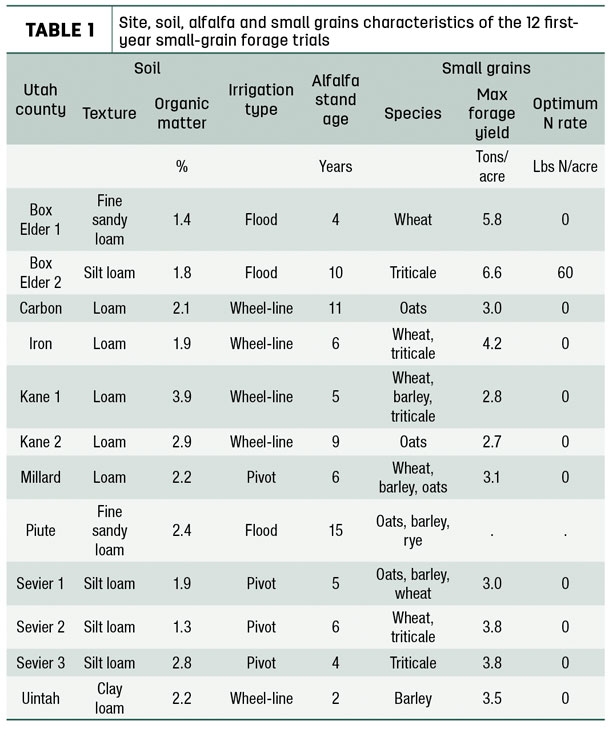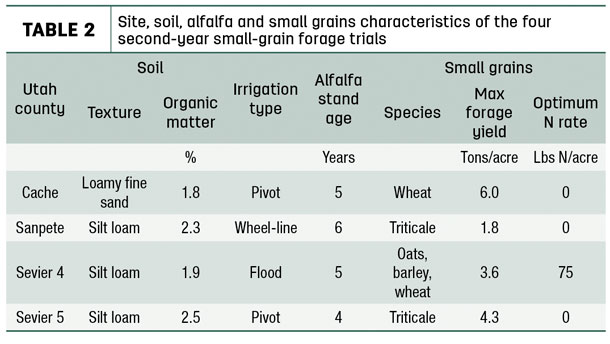Single or mixed species of small grains such as barley, wheat, oats and triticale are being used more frequently as rotation forage crops in the West, especially during drought years, as small-grain forages typically require less total irrigation than corn, and the timing of their irrigation needs (April – July) often better synchronizes with water availability from snowmelt, or “high water,” than corn in some areas of the West.
In addition to water savings, many growers utilize the shorter growing season of small grains to more rapidly return back to alfalfa or other rotational crops. Due to this reason, small-grain forages are often grown following alfalfa termination. Growing small-grain forage after alfalfa could provide an opportunity to reduce or eliminate nitrogen (N) fertilizer inputs due to nitrogen credits.
Alfalfa nitrogen credits
Like nearly all legumes, alfalfa has the ability to “fix” nitrogen. Due to this fixation and other factors, nitrogen availability from the soil is typically enhanced when alfalfa is terminated. This contribution is often referred to as a “nitrogen credit.” For this reason, N fertilization can often be reduced or eliminated for one to three years following alfalfa termination. In fact, previous research in over 30 trials in Utah, and another 60 trials in other states, has shown that growers can usually produce one, and sometimes two, years of corn without any N fertilizer. That can be a savings of up to $100 per acre each year.
Much less information exists on the nitrogen contribution of alfalfa to small grains, especially in the Intermountain West. In order to determine how nitrogen credits apply to small-grain forage, a large team of extension faculty and growers conducted on-farm research trials at 16 farm fields in Utah between 2018 to 2020.
Apply nitrogen in first year after alfalfa?
Research on Utah farm fields in 2018-19 (Table 1) showed that N fertilizer was needed to economically optimize small-grain forage yield in only one of 11 fields (9%) where yield was measured (excluding the Piute site).

The one field (Box Elder 2) that responded to fertilizer was small grains following a 10-year-old thin alfalfa stand, and it required 60 pounds N per acre to economically optimize yield (assuming 40 cents per pound of N and $55 per ton of forage). The stand in this field was thinning, and the low number of alfalfa plants likely contributed to low residual N for the small-grain crop. However, other fields also had old and thinning stands but did not require N fertilizer. Thus, other factors besides stand condition and age also contributed to fertilizer response.

Forage quality was measured on 12 fields. In contrast to yield results, N fertilizer applications did increase forage protein at 11 fields and relative feed quality (RFQ) at nine fields. Other forage quality measures such as neutral detergent fiber (NDF), total digestible nutrients (TDN) and relative feed value (RFV) were only impacted by N fertilizer in one to two fields. The average N fertilizer rate that optimized protein was 120 pounds N per acre (ranging from 70 to 150 pounds N per acre), and the average rate that optimized RFQ was 105 pounds N per acre (50 to 150 pounds N per acre). Protein increased from 11% to 15%, and RFQ increased from 42 to 74 across all responsive fields, when the optimal fertilizer rate was applied, compared to no fertilizer.
These results indicate that nitrogen should only be applied if forage protein or RFQ will increase your compensation. However, many small-grain forage producers in Utah have indicated they are mainly compensated for yield and not quality, so N application may often be unwarranted. According to most university guidelines, small grain- forage not following alfalfa would normally require between 75 and 150 pounds N per acre to optimize yield and quality. Thus, growers could save about $50 or more per acre on fertilizer, in most cases.











